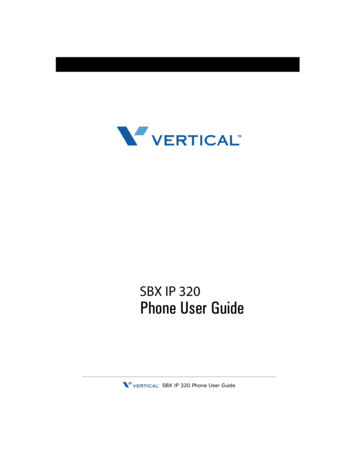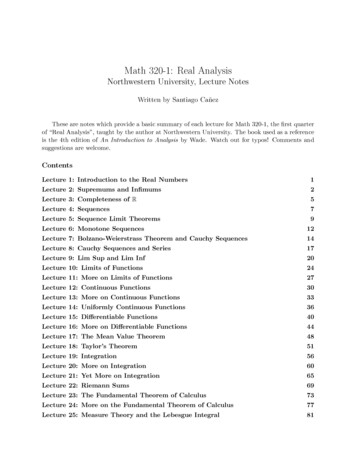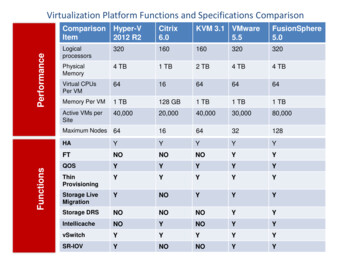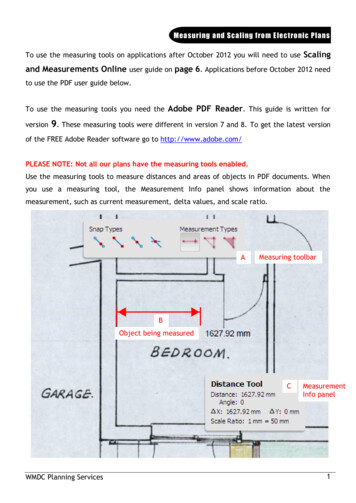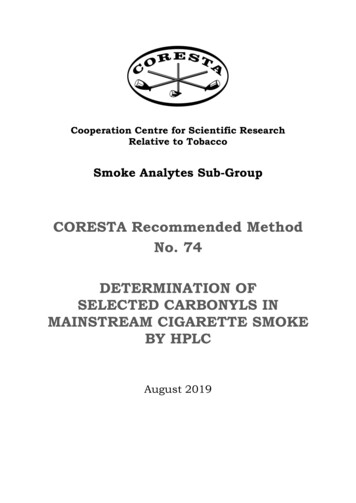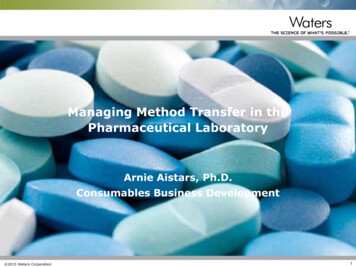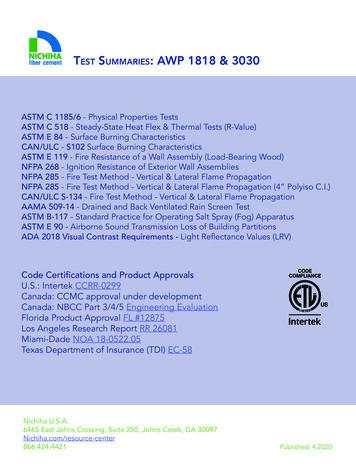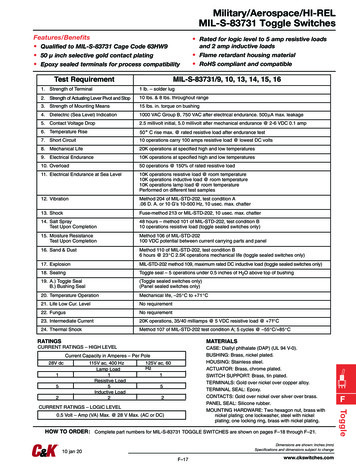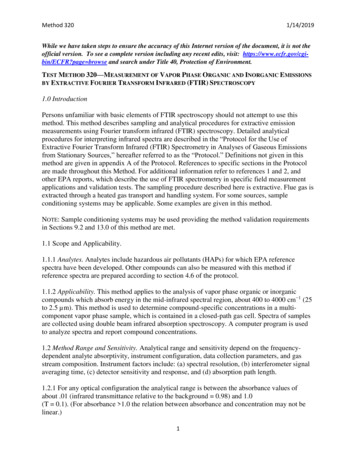
Transcription
Method 3201/14/2019While we have taken steps to ensure the accuracy of this Internet version of the document, it is not theofficial version. To see a complete version including any recent edits, visit: https://www.ecfr.gov/cgibin/ECFR?page browse and search under Title 40, Protection of Environment.TEST METHOD 320—MEASUREMENT OF VAPOR PHASE ORGANIC AND INORGANIC EMISSIONSBY EXTRACTIVE FOURIER TRANSFORM INFRARED (FTIR) SPECTROSCOPY1.0 IntroductionPersons unfamiliar with basic elements of FTIR spectroscopy should not attempt to use thismethod. This method describes sampling and analytical procedures for extractive emissionmeasurements using Fourier transform infrared (FTIR) spectroscopy. Detailed analyticalprocedures for interpreting infrared spectra are described in the “Protocol for the Use ofExtractive Fourier Transform Infrared (FTIR) Spectrometry in Analyses of Gaseous Emissionsfrom Stationary Sources,” hereafter referred to as the “Protocol.” Definitions not given in thismethod are given in appendix A of the Protocol. References to specific sections in the Protocolare made throughout this Method. For additional information refer to references 1 and 2, andother EPA reports, which describe the use of FTIR spectrometry in specific field measurementapplications and validation tests. The sampling procedure described here is extractive. Flue gas isextracted through a heated gas transport and handling system. For some sources, sampleconditioning systems may be applicable. Some examples are given in this method.NOTE: Sample conditioning systems may be used providing the method validation requirementsin Sections 9.2 and 13.0 of this method are met.1.1 Scope and Applicability.1.1.1 Analytes. Analytes include hazardous air pollutants (HAPs) for which EPA referencespectra have been developed. Other compounds can also be measured with this method ifreference spectra are prepared according to section 4.6 of the protocol.1.1.2 Applicability. This method applies to the analysis of vapor phase organic or inorganiccompounds which absorb energy in the mid-infrared spectral region, about 400 to 4000 cm 1 (25to 2.5 µm). This method is used to determine compound-specific concentrations in a multicomponent vapor phase sample, which is contained in a closed-path gas cell. Spectra of samplesare collected using double beam infrared absorption spectroscopy. A computer program is usedto analyze spectra and report compound concentrations.1.2 Method Range and Sensitivity. Analytical range and sensitivity depend on the frequencydependent analyte absorptivity, instrument configuration, data collection parameters, and gasstream composition. Instrument factors include: (a) spectral resolution, (b) interferometer signalaveraging time, (c) detector sensitivity and response, and (d) absorption path length.1.2.1 For any optical configuration the analytical range is between the absorbance values ofabout .01 (infrared transmittance relative to the background 0.98) and 1.0(T 0.1). (For absorbance 1.0 the relation between absorbance and concentration may not belinear.)1
Method 3201/14/20191.2.2 The concentrations associated with this absorbance range depend primarily on the cell pathlength and the sample temperature. An analyte absorbance greater than 1.0, can be lowered bydecreasing the optical path length. Analyte absorbance increases with a longer path length.Analyte detection also depends on the presence of other species exhibiting absorbance in thesame analytical region. Additionally, the estimated lower absorbance (A) limit(A 0.01) depends on the root mean square deviation (RMSD) noise in the analytical region.1.2.3 The concentration range of this method is determined by the choice of opticalconfiguration.1.2.3.1 The absorbance for a given concentration can be decreased by decreasing the path lengthor by diluting the sample. There is no practical upper limit to the measurement range.1.2.3.2 The analyte absorbance for a given concentration may be increased by increasing the cellpath length or (to some extent) using a higher resolution. Both modifications also cause acorresponding increased absorbance for all compounds in the sample, and a decrease in thesignal throughput. For this reason the practical lower detection range (quantitation limit) usuallydepends on sample characteristics such as moisture content of the gas, the presence of otherinterferants, and losses in the sampling system.1.3 Sensitivity. The limit of sensitivity for an optical configuration and integration time isdetermined using appendix D of the Protocol: Minimum Analyte Uncertainty, (MAU). TheMAU depends on the RMSD noise in an analytical region, and on the absorptivity of the analytein the same region.1.4 Data Quality. Data quality shall be determined by executing Protocol pre-test procedures inappendices B to H of the protocol and post-test procedures in appendices I and J of the protocol.1.4.1 Measurement objectives shall be established by the choice of detection limit (DLi) andanalytical uncertainty (AUi) for each analyte.1.4.2 An instrumental configuration shall be selected. An estimate of gas composition shall bemade based on previous test data, data from a similar source or information gathered in a pre-testsite survey. Spectral interferants shall be identified using the selected DLi and AUi and bandareas from reference spectra and interferant spectra. The baseline noise of the system shall bemeasured in each analytical region to determine the MAU of the instrument configuration foreach analyte and interferant (MIUi).1.4.3 Data quality for the application shall be determined, in part, by measuring the RMS (rootmean square) noise level in each analytical spectral region (appendix C of the Protocol). TheRMS noise is defined as the RMSD of the absorbance values in an analytical region from themean absorbance value in the region.1.4.4 The MAU is the minimum analyte concentration for which the AUi can be maintained; ifthe measured analyte concentration is less than MAUi then data quality are unacceptable.2
Method 3201/14/20192.0 Summary of Method2.1 Principle. References 4 through 7 provide background material on infrared spectroscopy andquantitative analysis. A summary is given in this section.2.1.1 Infrared absorption spectroscopy is performed by directing an infrared beam through asample to a detector. The frequency-dependent infrared absorbance of the sample is measured bycomparing this detector signal (single beam spectrum) to a signal obtained without a sample inthe beam path (background).2.1.2 Most molecules absorb infrared radiation and the absorbance occurs in a characteristic andreproducible pattern. The infrared spectrum measures fundamental molecular properties and acompound can be identified from its infrared spectrum alone.2.1.3 Within constraints, there is a linear relationship between infrared absorption and compoundconcentration. If this frequency dependent relationship (absorptivity) is known (measured), it canbe used to determine compound concentration in a sample mixture.2.1.4 Absorptivity is measured by preparing, in the laboratory, standard samples of compoundsat known concentrations and measuring the FTIR “reference spectra” of these standard samples.These “reference spectra” are then used in sample analysis: (1) Compounds are detected bymatching sample absorbance bands with bands in reference spectra, and (2) concentrations aremeasured by comparing sample band intensities with reference band intensities.2.1.5 This method is self-validating provided that the results meet the performance requirementof the QA spike in sections 8.6.2 and 9.0 of this method, and results from a previous methodvalidation study support the use of this method in the application.2.2 Sampling and Analysis. In extractive sampling a probe assembly and pump are used toextract gas from the exhaust of the affected source and transport the sample to the FTIR gas cell.Typically, the sampling apparatus is similar to that used for single-component continuousemission monitor (CEM) measurements.2.2.1 The digitized infrared spectrum of the sample in the FTIR gas cell is measured and storedon a computer. Absorbance band intensities in the spectrum are related to sample concentrationsby what is commonly referred to as Beer's Law.𝐴𝑖 𝑎𝑖 𝑏𝑐𝑖(1)Where:Ai absorbance at a given frequency of the ith sample component.ai absorption coefficient (absorptivity) of the ith sample component.3
Method 3201/14/2019b path length of the cell.ci concentration of the ith sample component.2.2.2 Analyte spiking is used for quality assurance (QA). In this procedure (section 8.6.2 of thismethod) an analyte is spiked into the gas stream at the back end of the sample probe. Analyteconcentrations in the spiked samples are compared to analyte concentrations in unspikedsamples. Since the concentration of the spike is known, this procedure can be used to determineif the sampling system is removing the spiked analyte(s) from the sample stream.2.3 Reference Spectra Availability. Reference spectra of over 100 HAPs are available in the EPAFTIR spectral library on the EMTIC (Emission Measurement Technical Information Center)computer bulletin board service and at internetaddress http://info.arnold.af.mil/epa/welcome.htm. Reference spectra for HAPs, or otheranalytes, may also be prepared according to section 4.6 of the Protocol.2.4 Operator Requirements. The FTIR analyst shall be trained in setting up the instrumentation,verifying the instrument is functioning properly, and performing routine maintenance. Theanalyst must evaluate the initial sample spectra to determine if the sample matrix is consistentwith pre-test assumptions and if the instrument configuration is suitable. The analyst must beable to modify the instrument configuration, if necessary.2.4.1 The spectral analysis shall be supervised by someone familiar with EPA FTIR Protocolprocedures.2.4.2 A technician trained in instrumental test methods is qualified to install and operate thesampling system. This includes installing the probe and heated line assembly, operating theanalyte spike system, and performing moisture and flow measurements.3.0 DefinitionsSee appendix A of the Protocol for definitions relating to infrared spectroscopy. Additionaldefinitions are given in sections 3.1 through 3.29.3.1 Analyte. A compound that this method is used to measure. The term “target analyte” is alsoused. This method is multi-component and a number of analytes can be targeted for a test.3.2 Reference Spectrum. Infrared spectrum of an analyte prepared under controlled, documented,and reproducible laboratory conditions according to procedures in section 4.6 of the Protocol. Alibrary of reference spectra is used to measure analytes in gas samples.3.3 Standard Spectrum. A spectrum that has been prepared from a reference spectrum through a(documented) mathematical operation. A common example is de-resolving of reference spectrato lower-resolution standard spectra (Protocol, appendix K to the addendum of this method).Standard spectra, prepared by approved, and documented, procedures can be used as referencespectra for analysis.4
Method 3201/14/20193.4 Concentration. In this method concentration is expressed as a molar concentration, in ppmmeters, or in (ppm-meters)/K, where K is the absolute temperature (Kelvin). The latter unitsallow the direct comparison of concentrations from systems using different opticalconfigurations or sampling temperatures.3.5 Interferant. A compound in the sample matrix whose infrared spectrum overlaps with part ofan analyte spectrum. The most accurate analyte measurements are achieved when referencespectra of interferants are used in the quantitative analysis with the analyte reference spectra. Thepresence of an interferant can increase the analytical uncertainty in the measured analyteconcentration.3.6 Gas Cell. A gas containment cell that can be evacuated. It is equipped with the opticalcomponents to pass the infrared beam through the sample to the detector. Important cell featuresinclude: path length (or range if variable), temperature range, materials of construction, and totalgas volume.3.7 Sampling System. Equipment used to extract the sample from the test location and transportthe sample gas to the FTIR analyzer. This includes sample conditioning systems.3.8 Sample Analysis. The process of interpreting the infrared spectra to obtain sample analyteconcentrations. This process is usually automated using a software routine employing a classicalleast squares (cls), partial least squares (pls), or K- or P-matrix method.3.9 One hundred percent line. A double beam transmittance spectrum obtained by combiningtwo background single beam spectra. Ideally, this line is equal to 100 percent transmittance (orzero absorbance) at every frequency in the spectrum. Practically, a zero absorbance line is usedto measure the baseline noise in the spectrum.3.10 Background Deviation. A deviation from 100 percent transmittance in any region of the 100percent line. Deviations greater than 5 percent in an analytical region are unacceptable(absorbance of 0.021 to 0.022). Such deviations indicate a change in the instrument throughputrelative to the background single beam.3.11 Batch Sampling. A procedure where spectra of discreet, static samples are collected. Thegas cell is filled with sample and the cell is isolated. The spectrum is collected. Finally, the cell isevacuated to prepare for the next sample.3.12 Continuous Sampling. A procedure where spectra are collected while sample gas is flowingthrough the cell at a measured rate.3.13 Sampling resolution. The spectral resolution used to collect sample spectra.3.14 Truncation. Limiting the number of interferogram data points by deleting points farthestfrom the center burst (zero path difference, ZPD).5
Method 3201/14/20193.15 Zero filling. The addition of points to the interferogram. The position of each added point isinterpolated from neighboring real data points. Zero filling adds no information to theinterferogram, but affects line shapes in the absorbance spectrum (and possibly analyticalresults).3.16 Reference CTS. Calibration Transfer Standard spectra that were collected with referencespectra.3.17 CTS Standard. CTS spectrum produced by applying a de-resolution procedure to areference CTS.3.18 Test CTS. CTS spectra collected at the sampling resolution using the same opticalconfiguration as for sample spectra. Test spectra help verify the resolution, temperature and pathlength of the FTIR system.3.19 RMSD. Root Mean Square Difference, defined in EPA FTIR Protocol, appendix A.3.20 Sensitivity. The noise-limited compound-dependent detection limit for the FTIR systemconfiguration. This is estimated by the MAU. It depends on the RMSD in an analytical region ofa zero absorbance line.3.21 Quantitation Limit. The lower limit of detection for the FTIR system configuration in thesample spectra. This is estimated by mathematically subtracting scaled reference spectra ofanalytes and interferences from sample spectra, then measuring the RMSD in an analyticalregion of the subtracted spectrum. Since the noise in subtracted sample spectra may be muchgreater than in a zero absorbance spectrum, the quantitation limit is generally much higher thanthe sensitivity. Removing spectral interferences from the sample or improving the spectralsubtraction can lower the quantitation limit toward (but not below) the sensitivity.3.22 Independent Sample. A unique volume of sample gas; there is no mixing of gas betweentwo consecutive independent samples. In continuous sampling two independent samples areseparated by at least 5 cell volumes. The interval between independent measurements depends onthe cell volume and the sample flow rate (through the cell).3.23 Measurement. A single spectrum of flue gas contained in the FTIR cell.3.24 Run. A run consists of a series of measurements. At a minimum a run includes 8independent measurements spaced over 1 hour.3.25 Validation. Validation of FTIR measurements is described in sections 13.0 through 13.4 ofthis method. Validation is used to verify the test procedures for measuring specific analytes at asource. Validation provides proof that the method works under certain test conditions.3.26 Validation Run. A validation run consists of at least 24 measurements of independentsamples. Half of the samples are spiked and half are not spiked. The length of the run isdetermined by the interval between independent samples.6
Method 3201/14/20193.27 Screening. Screening is used when there is little or no available information about a source.The purpose of screening is to determine what analytes are emitted and to obtain informationabout important sample characteristics such as moisture, temperature, and interferences.Screening results are semi-quantitative (estimated concentrations) or qualitative (identificationonly). Various optical and sampling configurations may be used. Sample conditioning systemsmay be evaluated for their effectiveness in removing interferences. It is unnecessary to perform acomplete run under any set of sampling conditions. Spiking is not necessary, but spiking can be auseful screening tool for evaluating the sampling system, especially if a reactive or solubleanalyte is used for the spike.3.28 Emissions Test. An FTIR emissions test is performed according specific sampling andanalytical procedures. These procedures, for the target analytes and the source, are based onprevious screening and validation results. Emission results are quantitative. A QA spike (sections8.6.2 and 9.2 of this method) is performed under each set of sampling conditions using arepresentative analyte. Flow, gas temperature and diluent data are recorded concurrently with theFTIR measurements to provide mass emission rates for detected compounds.3.29 Surrogate. A surrogate is a compound that is used in a QA spike procedure (section 8.6.2 ofthis method) to represent other compounds. The chemical and physical properties of a surrogateshall be similar to the compounds it is chosen to represent. Under given sampling conditions,usually a single sampling factor is of primary concern for measuring the target analytes: forexample, the surrogate spike results can be representative for analytes that are more reactive,more soluble, have a lower absorptivity, or have a lower vapor pressure than the surrogate itself.4.0 InterferencesInterferences are divided into two classifications: analytical and sampling.4.1 Analytical Interferences. An analytical interference is a spectral feature that complicates (inextreme cases may prevent) the analysis of an analyte. Analytical interferences are classified asbackground or spectral interference.4.1.1 Background Interference. This results from a change in throughput relative to the singlebeam background. It is corrected by collecting a new background and proceeding with the test.In severe instances the cause must be identified and corrected. Potential causes include: (1)Deposits on reflective surfaces or transmitting windows, (2) changes in detector sensitivity, (3) achange in the infrared source output, or (4) failure in the instrument electronics. In routinesampling throughput may degrade over several hours. Periodically a new background must becollected, but no other corrective action will be required.4.1.2 Spectral Interference. This results from the presence of interfering compound(s)(interferant) in the sample. Interferant spectral features overlap analyte spectral features. Anycompound with an infrared spectrum, including analytes, can potentially be an interferant. TheProtocol measures absorbance band overlap in each analytical region to determine if potentialinterferants shall be classified as known interferants (FTIR Protocol, section 4.9 and appendix7
Method 3201/14/2019B). Water vapor and CO2 are common spectral interferants. Both of these compounds havestrong infrared spectra and are present in many sample matrices at high concentrations relative toanalytes. The extent of interference depends on the (1) interferant concentration, (2) analyteconcentration, and (3) the degree of band overlap. Choosing an alternate analytical region canminimize or avoid the spectral interference. For example, CO2 interferes with the analysis of the670 cm 1benzene band. However, benzene can also be measured near 3000 cm 1 (with lesssensitivity).4.2 Sampling System Interferences. These prevent analytes from reaching the instrument. Theanalyte spike procedure is designed to measure sampling system interference, if any.4.2.1 Temperature. A temperature that is too low causes condensation of analytes or water vapor.The materials of the sampling system and the FTIR gas cell usually set the upper limit oftemperature.4.2.2 Reactive Species. Anything that reacts with analytes. Some analytes, like formaldehyde,polymerize at lower temperatures.4.2.3 Materials. Poor choice of material for probe, or sampling line may remove some analytes.For example, HF reacts with glass components.4.2.4 Moisture. In addition to being a spectral interferant, condensed moisture removes solublecompounds.5.0 SafetyThe hazards of performing this method are those associated with any stack sampling method andthe same precautions shall be followed. Many HAPs are suspected carcinogens or present otherserious health risks. Exposure to these compounds should be avoided in all circumstances. Forinstructions on the safe handling of any particular compound, refer to its material safety datasheet. When using analyte standards, always ensure that gases are properly vented and that thegas handling system is leak free. (Always perform a leak check with the system under maximumvacuum and, again, with the system at greater than ambient pressure.) Refer to section 8.2 of thismethod for leak check procedures. This method does not address all of the potential safety risksassociated with its use. Anyone performing this method must follow safety and health practicesconsistent with applicable legal requirements and with prudent practice for each application.6.0 Equipment and SuppliesNOTE: Mention of trade names or specific products does not constitute endorsement by theEnvironmental Protection Agency.The equipment and supplies are based on the schematic of a sampling system shown in Figure 1.Either the batch or continuous sampling procedures may be used with this sampling system.Alternative sampling configurations may also be used, provided that the data quality objectivesare met as determined in the post-analysis evaluation. Other equipment or supplies may benecessary, depending on the design of the sampling system or the specific target analytes.8
Method 3201/14/20196.1 Sampling Probe. Glass, stainless steel, or other appropriate material of sufficient length andphysical integrity to sustain heating, prevent adsorption of analytes, and to transport analytes tothe infrared gas cell. Special materials or configurations may be required in some applications.For instance, high stack sample temperatures may require special steel or cooling the probe. Forvery high moisture sources it may be desirable to use a dilution probe.6.2 Particulate Filters. A glass wool plug (optional) inserted at the probe tip (for largeparticulate removal) and a filter (required) rated for 99 percent removal efficiency at 1-micron(e.g., Balston”) connected at the outlet of the heated probe.6.3 Sampling Line/Heating System. Heated (sufficient to prevent condensation) stainless steel,polytetrafluoroethane, or other material inert to the analytes.6.4 Gas Distribution Manifold. A heated manifold allowing the operator to control flows of gasstandards and samples directly to the FTIR system or through sample conditioning systems.Usually includes heated flow meter, heated valve for selecting and sending sample to theanalyzer, and a by-pass vent. This is typically constructed of stainless steel tubing and fittings,and high-temperature valves.6.5 Stainless Steel Tubing. Type 316, appropriate diameter (e.g., 3 8 in.) and length for heatedconnections. Higher grade stainless may be desirable in some applications.6.6 Calibration/Analyte Spike Assembly. A three way valve assembly (or equivalent) to introduceanalyte or surrogate spikes into the sampling system at the outlet of the probe upstream of theout-of-stack particulate filter and the FTIR analytical system.6.7 Mass Flow Meter (MFM). These are used for measuring analyte spike flow. The MFM shallbe calibrated in the range of 0 to 5 L/min and be accurate to 2 percent (or better) of the flowmeter span.6.8 Gas Regulators. Appropriate for individual gas standards.6.9 Polytetrafluoroethane Tubing. Diameter (e.g., 3 8 in.) and length suitable to connect cylinderregulators to gas standard manifold.6.10 Sample Pump. A leak-free pump (e.g., KNFTM), with by-pass valve, capable of producing asample flow rate of at least 10 L/min through 100 ft of sample line. If the pump is positionedupstream of the distribution manifold and FTIR system, use a heated pump that is constructedfrom materials non-reactive to the analytes. If the pump is located downstream of the FTIRsystem, the gas cell sample pressure will be lower than ambient pressure and it must be recordedat regular intervals.6.11 Gas Sample Manifold. Secondary manifold to control sample flow at the inlet to the FTIRmanifold. This is optional, but includes a by-pass vent and heated rotameter.9
Method 3201/14/20196.12 Rotameter. A 0 to 20 L/min rotameter. This meter need not be calibrated.6.13 FTIR Analytical System. Spectrometer and detector, capable of measuring the analytes tothe chosen detection limit. The system shall include a personal computer with compatiblesoftware allowing automated collection of spectra.6.14 FTIR Cell Pump. Required for the batch sampling technique, capable of evacuating theFTIR cell volume within 2 minutes. The pumping speed shall allow the operator to obtain 8sample spectra in 1 hour.6.15 Absolute Pressure Gauge. Capable of measuring pressure from 0 to 1000 mmHg to within 2.5 mmHg (e.g., BaratronTM).6.16 Temperature Gauge. Capable of measuring the cell temperature to within 2 C.6.17 Sample Conditioning. One option is a condenser system, which is used for moistureremoval. This can be helpful in the measurement of some analytes. Other sample conditioningprocedures may be devised for the removal of moisture or other interfering species.6.17.1 The analyte spike procedure of section 9.2 of this method, the QA spike procedure ofsection 8.6.2 of this method, and the validation procedure of section 13 of this methoddemonstrate whether the sample conditioning affects analyte concentrations. Alternatively,measurements can be made with two parallel FTIR systems; one measuring conditioned sample,the other measuring unconditioned sample.6.17.2 Another option is sample dilution. The dilution factor measurement must be documentedand accounted for in the reported concentrations. An alternative to dilution is to lower thesensitivity of the FTIR system by decreasing the cell path length, or to use a short-path cell inconjunction with a long path cell to measure more than one concentration range.7.0 Reagents and Standards7.1 Analyte(s) and Tracer Gas. Obtain a certified gas cylinder mixture containing all of theanalyte(s) at concentrations within 2 percent of the emission source levels (expressed in ppmmeter/K). If practical, the analyte standard cylinder shall also contain the tracer gas at aconcentration which gives a measurable absorbance at a dilution factor of at least 10:1. Two ppmSF6 is sufficient for a path length of 22 meters at 250 F.7.2 Calibration Transfer Standard(s). Select the calibration transfer standards (CTS) accordingto section 4.5 of the FTIR Protocol. Obtain a National Institute of Standards and Technology(NIST) traceable gravimetric standard of the CTS ( 2 percent).7.3 Reference Spectra. Obtain reference spectra for each analyte, interferant, surrogate, CTS, andtracer. If EPA reference spectra are not available, use reference spectra prepared according toprocedures in section 4.6 of the EPA FTIR Protocol.10
Method 3201/14/20198.0 Sampling and Analysis ProcedureThree types of testing can be performed: (1) Screening, (2) emissions test, and (3) validation.Each is defined in section 3 of this method. Determine the purpose(s) of the FTIR test. Testrequirements include: (a) AUi, DLi, overall fractional uncertainty, OFUi, maximum expectedconcentration (CMAXi), and tAN for each, (b) potential interferants, (c) sampling system factors,e.g., minimum absolute cell pressure, (Pmin), FTIR cell volume (VSS), estimated sampleabsorption pathlength, LS′, estimated sample pressure, PS′, TS′, signal integration time (tSS),minimum instrumental linewidth, MIL, fractional error, and (d) analytical regions, e.g., m 1 toM, lower wavenumber position, FLm, center wavenumber position, FCm, and upper wavenumberposition, FUm, plus interferants, upper wavenumber position of the CTS absorption band, FFUm,lower wavenumber position of the CTS absorption band, FFLm, wavenumber range FNU toFNL. If necessary, sample and acquire an initial spectrum. From analysis of this preliminaryspectrum determine a suitable operational path length. Set up the sampling train as shown inFigure 1 or use an appropriate alternative configuration. Sections 8.1 through 8.11 of this methodprovide guidance on pre-test calculations in the EPA protocol, sampling and analyticalprocedures, and post-test protocol calculations.8.1 Pretest Preparations and Evaluations. Using the procedure in section 4.0 of the FTIRProtocol, determine the optimum sampling system configuration for measuring the targetanalytes. Use available information to make reasonable assumptions about moisture content andother interferences.8.1.1 Analytes. Select the required detection limit (DLi) and the maximum
measurements using Fourier transform infrared (FTIR) spectroscopy. Detailed analytical procedures for interpreting infrared spectra are described in the “Protocol for the Use of Extractive Fourier Transform Infrared (FTIR) Spectrometry in Analyses of Gaseous Emissions from Stat
